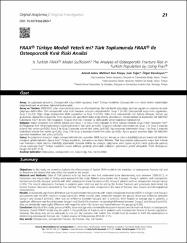| dc.contributor.author | Aslan, Ahmet | |
| dc.contributor.author | Konya, Mehmet Nuri | |
| dc.contributor.author | Yağcı, Şule | |
| dc.contributor.author | Karakoyun, Özgür | |
| dc.date.accessioned | 2022-05-11T14:36:10Z | |
| dc.date.available | 2022-05-11T14:36:10Z | |
| dc.date.issued | 2014 | |
| dc.identifier.issn | 2147-2653 | |
| dc.identifier.uri | https://app.trdizin.gov.tr/makale/TVRZNU9EQXlNZz09 | |
| dc.identifier.uri | https://hdl.handle.net/20.500.11776/8396 | |
| dc.description.abstract | Amaç: Bu çalışmada amacımız, Osteoporotik kalça kırıklı olgularda, Frax® Türkiye modelinin Osteoporotik kırık riskini tahmin edebilirliğini değerlendirmek ve etkileyen faktörleri belirlemekti. Gereç ve Yöntem: 2009-2012 yılları arasında Kastamonu ve Afyonkarahisar İllerinde kemik yoğunluğu taraması yapılan ve onamları alınarak çalışmaya dahil edilen 104 osteoporotik kalça kırıklı hastanın sonuçları değerlendirildi. Grup 1 (n=36): Osteoporotik kalça kırıklı olgulardan, Grup 2 (n=33): Diğer bölge osteoporotik kırıklı olgulardan ve Grup 3 (n=35): Daha önce osteoporotik kırık öyküsü olmayan, benzer yaş grubundaki olgulardan oluşuyordu. Tüm olguların son geçirdikleri kalça kırığı dikkate alınmaksızın, önceki kırıkları ve kaydedilen risk faktörleri kullanılarak Frax ® ile kırık riski hesaplandı. Gruplar kırık riski, t-skorları ve demografk verileri bakımdan karşılaştırıldı. Bulgular: Major ortopedik kırık (MOK) öyküsü olan Grup 1 ve Grup 2deki hastalar ile MOK öyküsü olmayan Grup 3 deki hastaların Frax ® ile hesaplanan kırık riskleri bakımından istatistiksel anlamlı fark vardı. (p<0,05). Grupların t-skorları bakımından ise: Grup 1 ile Grup 3 arasında anlamlı fark varken (p<0,05), Grup 2 ile Grup 3 arasında anlamlı fark yoktu (p>0,05). Yaş ortalaması bakımından Grup 1 ile Grup 3 arasında istatistiksel anlamlı fark varken (p<0,05), Grup 2 ile Grup 3 arasında anlamlı fark yoktu (p>0,05). Ayrıca gruplar arasında diğer risk faktörleri açısından istatistiksel fark yoktu (p>0,05). Sonuç: Bu çalışmanın sonuçları; major osteoporotik kırık riski açısından; MOK öyküsü, ileri yaş ve t-skoru düşüklüğünün en önemli risk faktörleri olduğunu göstermektedir. Ayrıca Frax ® Türkiye modelinin, Kastamonu ve Afyon İllerinde, Türk toplumunda osteoporotik major kırık ihtimali olan hastaların riskini tahmin edebildiği söylenebilir. Bununla birlikte bu sonuçlar, çalışmanın sınırlı sayıda seçilmiş hasta grubunda yapılmış olması nedeniyle Frax ® Türkiye modelinin revize edilmesi gerektiği yönündeki endişeleri gidermekte yeterli olmayabilir. | en_US |
| dc.description.abstract | Objectives: In this study, we aimed to evaluate the effectiveness of Turkish FRAX model in the prediction of osteoporotic fracture risk and to determine the factors that may affect the results in this model. Material and Methods: Data of 104 patients with hip fracture who had underwent bone densitometry scan between 2009-2012, in Kastamonu and Afyon cities in Turkey, were assessed in this study. Patients were divided into 3 groups. Group-1; patients with osteoporotic hip fractures (n=36), Group-2; patients with other osteoporotic bone fractures (n=33), Group-3; patients with no osteoporotic fracture history (n=35). The recent osteoporotic fractures in patients were ruled out and by noting the former fractures and previously determined risk factors, fracture risks were calculated by Frax method. The groups were compared on the basis of fracture risks, t-scores and demographical characteristics. Results: A statistically signifcant difference was found between the patients with major osteoporotic fracture (MOF) in Group-1 and Group-2 and patients with no MOF history in Group-3 (p<0.05). When t-scores were compared between the groups, there was difference between Group-1 and Group-3 (p<0.05), there was no difference between Group-2 and 3 (p>0.05). With respect to average age in patients, a signifcant difference was found between Group-1 and 3(p<0.05), however, no statistical difference between Group-2 and Group-3 (p>0.05). Also, no statistically meaningful difference with regard to other risk factors was found between the groups (p>0.05). Conclusion: Results of this study: previous MOFs, advanced age and a remarkable decrease in t-scores are the main risk factors in osteoporotic fractures. Turkish FRAX® model may be useful in the prediction of fracture risk in patients with increased risk factors in Turkish population. However, this study may not be adequate to rule out the concerns that Turkish Frax model must be revised to fulfll the expectations in determining osteoporotic fracture risk. | en_US |
| dc.language.iso | tur | en_US |
| dc.rights | info:eu-repo/semantics/openAccess | en_US |
| dc.subject | Anestezi | en_US |
| dc.subject | Tıbbi Araştırmalar Deneysel | en_US |
| dc.subject | Ortopedi | en_US |
| dc.title | Frax® Türkiye modeli yeterli mi? Türk toplumunda frax® ile osteoporotik kırık riski analizi | en_US |
| dc.title.alternative | Is Turkish Frax® model suffcient? the analysis of osteoporotic fracture risk in Turkish population by using Frax® | en_US |
| dc.type | article | en_US |
| dc.relation.ispartof | Türk Osteoporoz Dergisi | en_US |
| dc.department | Fakülteler, Tıp Fakültesi, Cerrahi Tıp Bilimleri Bölümü, Ortopedi ve Travmatoloji Ana Bilim Dalı | en_US |
| dc.identifier.volume | 20 | en_US |
| dc.identifier.issue | 1 | en_US |
| dc.identifier.startpage | 21 | en_US |
| dc.identifier.endpage | 25 | en_US |
| dc.institutionauthor | Karakoyun, Özgür | |
| dc.identifier.trdizinid | TVRZNU9EQXlNZz09 | en_US |



















